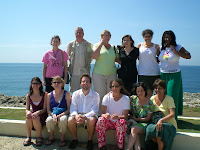 We arrived in the resort town of Juan Dolio on Friday and were surprised by the luxury of this all-inclusive resort. A beautiful spot right on the water, the resort boasted a wide variety of restaurants, shops, activities, and even resident flamingos and peacocks. Our group settled in and headed straight for the beach to enjoy a day of relaxation at the end of our trip. As much as the hotel and grounds were beautiful and we enjoyed our time in the sun, I think the group would agree that it was a stark contrast to our time in San Cristobal.
We arrived in the resort town of Juan Dolio on Friday and were surprised by the luxury of this all-inclusive resort. A beautiful spot right on the water, the resort boasted a wide variety of restaurants, shops, activities, and even resident flamingos and peacocks. Our group settled in and headed straight for the beach to enjoy a day of relaxation at the end of our trip. As much as the hotel and grounds were beautiful and we enjoyed our time in the sun, I think the group would agree that it was a stark contrast to our time in San Cristobal.After seeing how a small group of Dominicans lives through host family stays, we were humbled by the daily challenges they face. Even the most affluent families must deal with power outages, limited running water, or poor access to resources. It's a daily reality in the DR, so it was shocking to see a place where such resources were in abundance and used in excess. The resort felt like tourism bubble, where you were issued a bracelet at check-in that gave you unlimited access to endless food, activities, and all of life's pleasures. To see a place like this in such close geographic proximity to where we had just been was a transition that was difficult to swallow.

During our final dinner and our closing group discussion, we tried to make sense of the four different contexts we were exposed to in just seven days: the colonial city of Santo Domingo, the small town of Cambita Garabitos, the nearby city of San Cristobal, and the resort town of Juan Dolio. Each of these locations presented a different side of the DR. None of these places alone encompasses the Dominican experience, and even all four combined are just a slice of life in this diverse Caribbean nation. We realized that we had seen places that were only a 2-hour drive from the capital, a small fraction of the myriad towns, natural wonders, and models of daily life that exist here.
When we arrived, our group was interested in finding the "real" Dominican Republic. After our week-long study tour, we came to t
 he conclusion that none of these places is more "real" than the others. All of these places combined--these samples of life here--are the "real" DR. This country is taking advantage of economic development opportunities centered around tourism, leading to the resorts and tourist centers that dot the coastline. By experiencing what most tourists experience, even if just for one day, we had an appreciation for just how limited most visitors' understanding of the country can be.
he conclusion that none of these places is more "real" than the others. All of these places combined--these samples of life here--are the "real" DR. This country is taking advantage of economic development opportunities centered around tourism, leading to the resorts and tourist centers that dot the coastline. By experiencing what most tourists experience, even if just for one day, we had an appreciation for just how limited most visitors' understanding of the country can be.As we return to our classrooms and schools, we are each inspired to bring back stories, pictures, and information to our students in order to complicate their thinking about a country they may barely know. Through our eyes, our friends and families back home can begin to understand this unique country and all of the gifts it has to offer. We had a wonderful experience in the Dominican Republic and hope to return in the future, in order to continue to develop the relationships we initiated during our short time here. Thank you for taking the time to read our stories and learn about our adventure as it unfolded. We hope that this blog, in some small way, inspires you to travel and learn more about the world. We're already eager to plan our next trip!
Muchisimas gracias,
Julia de la Torre (on behalf of Primary Source and our adventurous crew (Jim, Flavien, Gretchen, Diane, Cori, Jill, Bwanda, Anne, Laura, Georgia, and Aleida)
Photos: 1) view of the beach at Juan Dolio, 2) flamingos on the grounds of the resort, 3) Bwanda O. and Jasmine, one of our hosts, 4) the group on our last day





 [from April 20, 2010]
[from April 20, 2010]










